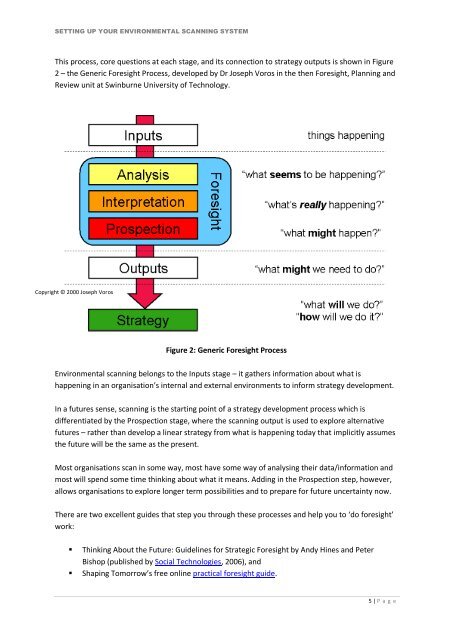Environmental Scanning - Thinking Futures
Environmental Scanning - Thinking Futures
Environmental Scanning - Thinking Futures
Create successful ePaper yourself
Turn your PDF publications into a flip-book with our unique Google optimized e-Paper software.
SETTING UP YOUR ENVIRONMENTAL SCANNING SYSTEM<br />
This process, core questions at each stage, and its connection to strategy outputs is shown in Figure<br />
2 – the Generic Foresight Process, developed by Dr Joseph Voros in the then Foresight, Planning and<br />
Review unit at Swinburne University of Technology.<br />
Copyright © 2000 Joseph Voros<br />
Figure 2: Generic Foresight Process<br />
<strong>Environmental</strong> scanning belongs to the Inputs stage – it gathers information about what is<br />
happening in an organisation’s internal and external environments to inform strategy development.<br />
In a futures sense, scanning is the starting point of a strategy development process which is<br />
differentiated by the Prospection stage, where the scanning output is used to explore alternative<br />
futures – rather than develop a linear strategy from what is happening today that implicitly assumes<br />
the future will be the same as the present.<br />
Most organisations scan in some way, most have some way of analysing their data/information and<br />
most will spend some time thinking about what it means. Adding in the Prospection step, however,<br />
allows organisations to explore longer term possibilities and to prepare for future uncertainty now.<br />
There are two excellent guides that step you through these processes and help you to ‘do foresight’<br />
work:<br />
• <strong>Thinking</strong> About the Future: Guidelines for Strategic Foresight by Andy Hines and Peter<br />
Bishop (published by Social Technologies, 2006), and<br />
• Shaping Tomorrow’s free online practical foresight guide.<br />
5 | P a g e



